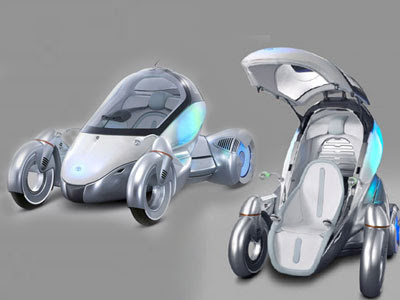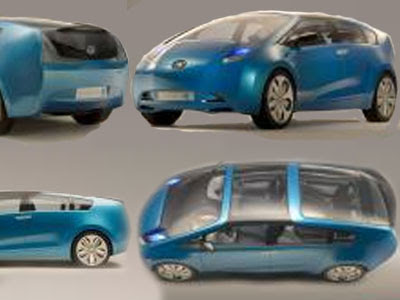The Toyota Avalon was a uniquely American project, with a number of ex-GM engineers were involved in lengthening the Camry, upgrading its interior, and improving its ride to create the Avalon.
All Avalons are made in the United States (Kentucky), even those exported to other parts of the world, where they are not quite as popular, due to their size and thirst. (The Camry itself is considered large in most areas, but is merely mid-sized in the United States.) The Avalon was also the first Toyota to be classified as a ‘domestic’ vehicle by the EPA, for CAFE purposes.
The Avalon didn’t take off when first introduced; it looked like a long, wide Camry, which was what it was, and the somewhat plain interior didn’t help. Critics praised the interior space, comfort, and quietness, but slammed the gas mileage, acceleration, and cornering.
The redesigned 2000-2006 Toyota Avalon was styled at Toyota’s Calty Design Center in Newport Beach, Calif. The next generation would take hints from the Crown Victoria around the grille, from the Lincoln in the rear, and from Buick in the dashboard, while dropping all visual cues linking it to the Camry. It had a single engine, a 3.0-liter V6 engine with Variable Valve Timing (VVT-i) for excellent fuel efficiency and lower emissions. The engine produced 210 horsepower at 5,800 rpm and 220 lbs./ft. of torque at 4,400 rpm. Estimated fuel economy was an admirable (for the size) 21 mpg city and 29 mpg highway. The engine had a new electronically controlled Active Control Mount (ACM) designed to reduce engine idle vibration; it drove the wheels through a four-speed electronically controlled automatic overdrive transmission with intelligence.
0-60 times dropped down to just below 8 seconds (7.9), on par with the Chrysler big cars which were then popular (Concorde, 300M, LHS) and similarly priced (Avalon sold for around $26,000 to $32,000).
The width increased by an inch, the front seat was moved up an inch, the roof moved up an inch, and the rear seat went back and up by an inch. At the same time, the instrument panel moved up four inches. The overall effect is American-style space; not quite Intrepid, but Impala size at least.
The cruise control was on the steering wheel, and there was a large trip computer section in the middle of the car (optional on the lower trim line). The instrument layout was completely different. The center console included warning lamps, the odometer and trip meter, clock, and outside temperature. The XLS version included a compass, trip computer, and calendar. Dual climate control was new to the Avalon for 2000, with vents for rear passengers on XLS models with bucket seats. An integrated dust and pollen filter was optional. The sound system went up to 120 watts, with a standard CD and cassette player.
The Avalon's handling still reflected its Camry base: not bad, but not exceptional, either. The ride was very nice with little road noise. The Toyota suspension was complemented by increased body stiffness and refined tuning. The comfortable ride of the second generation Avalon was accompanied by better cornering - admittedly still not top of class, but a far more acceptable compromise given the gentle ride.
Second-generation Toyota Avalon safety features included skid control, traction control, and Brake Assist (optional on XLS models). Brake Assist detected emergency braking and applied supplemental pressure. The rear-view mirror was also made larger. The body design absorbed energy in a crash, with energy absorbing material in the roof rails, front pillars and center pillars; and an in-trunk release handle for 2001.
The Avalon's cab-forward styling, steep windshield angle, rounded A-pillars, thicker glass, and recessed wiper blades all contributed to a significant reduction in wind noise. The Avalon used injection molded rocker-trim and a foam underbody coating to help prevent "stone pecking” noise.
We liked the straight-line acceleration of the second-generation Avalon, while finding the cornering ability to be far below many similarly sized cars — particularly the Eagle Vision and Dodge Intrepid — with the suspension focused on absorbing bumps rather than turning corners. The Avalon plowed into turns, rolling its body and often squealing its tires, but it wasn’t designed for that. It also provided the kind of smooth ride most cars can only dream of, isolating its passengers in Lexus-style luxury. The interior to be surprisingly and gratifyingly quiet; only the dashboard, which appeared to have been taken straight from an early-1980s Chevrolet, seemed out of place.
The Avalon XL had a trip meter, clock, and thermometer in the instrument panel; the Avalon XLS adds a compass, instant fuel economy, average speed, average fuel economy, trip time meter, fuel range meter, and and calendar. A dual climate control system provides independent heating, ventilation and air conditioning (HVAC) temperature adjustment between driver and passenger. On XLS bucket seat models, the system includes ventilation outlets for the rear seat occupants. Standard on the Avalon XLS, and available as a dealer-installed option on the XL, is an HVAC-integrated micron dust and pollen filter system.
Other comfort and convenience features included:
- Illuminated entry system
- One-touch auto-down/auto-up driver's window with jam protection
- Standard universal remote garage door opener (XLS only)
- Available one-touch power tilt/slide moonroof with jam protection
- Dual double sun visors with extensions
- Power door locks with auto-lock function
The standard audio system had a 3-in-1 combination of CD, cassette and AM/FM receiver with 120 watts of power. The premium grade audio was developed in conjunction with JBL and includes exceptional high and low frequency extension and clarity. This is achieved by adopting a separate five-channel, 250-watt amplifier. The system includes 3-in-1 functions with an available integrated six-CD changer on XLS models.
Further comfort and convenience features include front and rear cupholders, the large center console bin includes a 12-volt power point and a socket is incorporated for easy charging and storing of a cellular phone. An optional 115-volt A/C outlet - - capable of powering small electronic devices - - is located behind the center console on bucket seat models and on the instrumentation panel on bench seat models. A locking pass-through door behind the fold-down rear seat armrest allows long items like skis to be easily transported inside the vehicle.





























